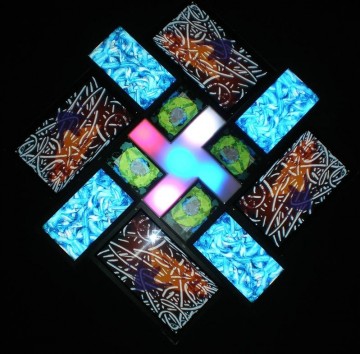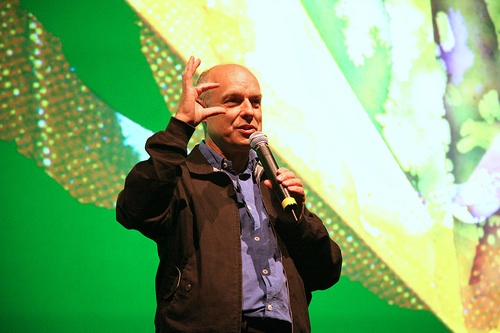
Originally published in the Northside San Francisco in November 2009
Brian Eno’s 77 Million Paintings at California State University Long Beach Art Museum- September 12 through December 13, 2009
I’m very good with technology, I always have been, and with machines in general. They seem not threatening like other people find them, but a source of fun and amusement. —Brian Eno
Brian Eno has a resume that’s even longer than his name. Brian Peter George St. John le Baptiste de la Salle Eno was born in 1948 in Suffolk, England. Although he is an artist, producer, writer and more, he was first known as an avant garde musician with the pioneering rock band Roxy Music. Later he became known as one of the forerunners of ambient music, and he went on to produce recordings for bands such as U2 and Coldplay.
Like many British rockers of the late 60’s and early 70’s, Eno’s career was birthed during art school. The Winchester School of Art was where Eno first began experimenting with light installations and where he developed his appreciation for principles of chance as applied to both visual art and music.
Eno’s latest endeavor is his experimental installation 77 Million Paintings. Premiering at the Venice Biennale in June 2007, 77 Million Paintings consists of a variety of video screens connected to computers each containing four banks of image data. The program randomly selects images from each bank which fade into one another to create constantly undulating imagery. Since there are 100 images in each bank, 77 Million Paintings represents the total number of possible combinations. The visuals are temporary and therefore impossible to recapture, creating an aesthetic of transience. Each combination quickly moves into extinction only to be replaced with a new sequence.

This installation is currently on display at the California State University Long Beach Art Museum. On September 21, 2009, Eno lectured about this exhibit at the Carpenter Center for Performing Arts in Long Beach, CA. “I don’t have ideas that turn into art; I make things and then ask ‘Why do I like it?’” Eno started his lecture with a lengthy historical detour. During the 1500’s, the astronomer Copernicus published his groundbreaking ideas about the heliocentric nature of the universe. It was then, Eno pointed out, that we realized that the earth and the galaxy to which it belonged was not at the center of the universe but was instead part of a vast cosmology. In 1859, Darwin’s The Origin of Species further removed humanity’s sense of centrality through the realization that we are one among thousands of species existing in a complex ecological web.
“I do tend to go on a bit”, Eno joked. He explained that contemporary definitions of art grew out of these philosophies, and that art has become another web of potentiality instead of a centralized, linear process. 77 Million Paintings has effectively eliminated the artist’s intent since Eno can no longer control the outcome of the work. It can’t be finished in a traditional sense, as there is no end point. Similarly, the viewer sees a different mixture each time as the series of pictures are in a perpetual state of regeneration. “I’m constantly surprised by what this installation shows me”, Eno commented. He frantically tried to capture snapshots of the fleeting pictures during the earliest days of 77 Million Paintings’ existence only to discover that trying to recreate these moments on film was beside the point. &ld quo;This was a learning process for me, a process of surrender.” The artist-as-creator identity dissolved like the rapidly changing paintings in the installation. Under these circumstances, Eno explained, an artist becomes someone who starts things, someone who puts events into motion creating results that cannot be predicted.
The viewer enters surrender mode as well. Onstage Eno humorously pantomimed the fast-paced, twitchy art goers that quickly enter the gallery as if to say “I’m very busy; I have a lot of art to look at today!” He then described how these same gallery attendees gradually unwind in front of the morphing color and light. “Their bodies start to relax, and some people even fall asleep!” Unlike many artists, Eno considers this a compliment.
77 Million Paintings also has a computer software application which is commercially available for those seeking to experience the work on a smaller scale. Whether on your computer screen or in the gallery, enjoy the simple visual beauty of 77 Million Paintings, relax, contemplate the space we occupy in the cosmos, or fall asleep. It’s all the same in the gospel according to Brian Eno.